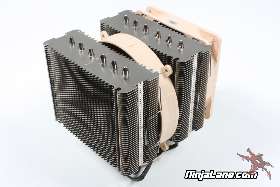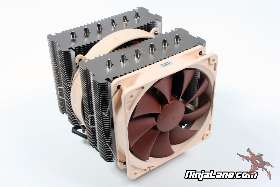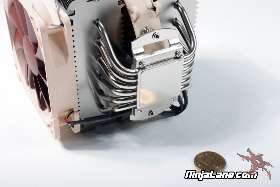After careful consideration I have decided to transfer all hardware review activities to a new domain. I purchased Hardwareasylum.com in 2012 and have been working hard to build a new and improved Ninjalane on that domain. If you are reading this you have reached one of the archived articles, news, projects and/or reviews that were left behind during the site migration.
Please update your bookmarks and be sure to visit the new and improved Ninjalane at Hardwareasylum.com
Noctua NH-D14 Heatsink Review
Author: Dennis Garcia
Published: Thursday, April 29, 2010
Introduction
Cooling a processor can be a real challenge when you are looking for good performance with a minimum of noise. Typically you'll have to sacrifice something along the way. High performance normally means a higher noise threshold, while quiet heatsinks usually don't cool very well. Of course these factors are all relative and we often use the OEM cooler as the benchmark.
In this review we will be looking at a popular heatsink from Noctua that has created a perfect balance between performance and noise control and is called, the NH-D14. Noctua is a premier cooling company from Austria that has focused on creating the best, and quietest, cooling solutions on the market. They do this by looking at the source of noise and finding ways to reduce it to a minimum.
In this review we will be looking at a popular heatsink from Noctua that has created a perfect balance between performance and noise control and is called, the NH-D14. Noctua is a premier cooling company from Austria that has focused on creating the best, and quietest, cooling solutions on the market. They do this by looking at the source of noise and finding ways to reduce it to a minimum.
The Noctua NH-D14 is a dual tower heatsink built on a 6 heatpipe design. As we all know heatsink performance is largely based on how fast you can move heat from one place to another. In the case of air cooling a fan is tasked with moving air across the heatsink thus starting the thermal transfer. The more surface area you have, the better the heat transfer.
Noctua has included 2 fans with the NH-D14. The NF-P12 is located on the outside of the heatsink while the NF-P14 is located in the middle between the towers. Both fans feature SSO Bearings and Vortex Control Notches to reduce fan noise.
Both fans are mounted to the heatsink using the traditional wire clip method but feature noise isolators to reduce any vibration that may transfer to the heatsink towers. Removing the fans is extremely easy, unlike some of the other wire clip designs we have seen.
Noctua has included 2 fans with the NH-D14. The NF-P12 is located on the outside of the heatsink while the NF-P14 is located in the middle between the towers. Both fans feature SSO Bearings and Vortex Control Notches to reduce fan noise.
Both fans are mounted to the heatsink using the traditional wire clip method but feature noise isolators to reduce any vibration that may transfer to the heatsink towers. Removing the fans is extremely easy, unlike some of the other wire clip designs we have seen.
Unlike traditional heatsink towers the 6 heatpipes are evenly spaces across the radiator array in a pattern that promotes spreading the heat load across the pipes instead of focusing on the center 2 to do all of the work.
The heatsink base is machined flat and features a micro texture that we find does extremely well at removing excess air from the thermal paste and promotes good adhesion to the heatspreader. If your heatsinks don't require a little force to remove them then you didn't make good contact.
The heatsink base is machined flat and features a micro texture that we find does extremely well at removing excess air from the thermal paste and promotes good adhesion to the heatspreader. If your heatsinks don't require a little force to remove them then you didn't make good contact.





